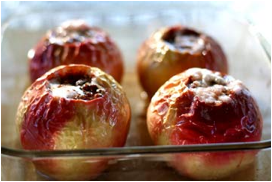Many people are familiar with the phrase, “an apple-a-day keeps the doctor away.” Recent studies show that the whole apple, skin included, may be helpful in keeping the oncologist away. Choosemyplate.org recommends that a healthy diet should include half a plate-full of fruits and vegetables for each meal. This recommendation includes whole, cut, or pureed fruits and vegetables that are fresh, frozen, canned, or dried. Apples are certainly on the list of healthy foods to include in your diet, but much of the goodness of apples often gets tossed in the trash can, not eaten. Nutrient-dense foods like apples, and other fruits and vegetables, may reduce the risk of some cancers when regularly included in a healthy diet. According to Dr. Michael Greger, M.D., recent research shows that the vitamins, minerals, and antioxidants found in the skin of apples may suppress certain tumor genes that help kill off breast and prostate cancer cells.
What’s so special about the skin of an apple? In his video, Apple Skin: Peeling Back Cancer, Dr. Greger highlights research that shows the effect of antioxidant-rich apple peel extract on breast and prostate cancer cells. “Neither the prostate nor the breast cancer cells were very happy,” Dr. Greger commented on the results of the experiment. Both breast and prostate cancer cells have a tumor suppressor gene that can help to kill cancer cells, but the gene is inactive. Apple peel extract appeared to turn the tumor suppressor gene on, which reduced the total number of cancer cells in each sample studied. This study described by Dr. Gregor on his informational website, NutritionFacts.org, suggests that because of the effect that apple skins have on certain cancer cells, apple skins “should not be discarded from the diet.”
It is important to remember that many of the nutrients found in fruits and vegetables are most abundant within the part that people often throw away: the skin. In many recipes calling for apples, peeling the skin off is mainly for looks. When microwaving or baking apples, the skin becomes soft enough to easily slice through, so why not keep it on? For fresh fruit, an apple corer is wonderful for taking out the core, yet leaving the goodness of the flesh and skin for a convenient snack. Here is great recipe for baked apples that makes a quick and easy snack or dessert, and it includes the nutritional benefits from the apple skin!
- 4 Large Apples
- 1/4 cup Brown Sugar
- 1 teaspoon Cinnamon
- 1/4 cup Chopped Pecans
- 1/4 cup Chopped Raisins
- 1 tablespoon Butter
- 3/4 cup Boiling Water
- Preheat oven to 375°F. Wash apples with hot, soapy water. Remove cores to 1/2 inch of the bottom of the apples. It helps if you have an apple corer, but if not, you can use a paring knife to cut out first the stem area, and then the core. Use a spoon to dig out the seeds. Make the holes about 3/4-inch to an inch wide. Remove as little flesh as possible.
- In a small bowl, combine the sugar, cinnamon, raisins, and pecans. Place apples in a 8-inch-by-8-inch square baking pan. Stuff each apple with this mixture. Top each apple with a dot of butter (1/4 of the tablespoon).
- Add boiling water to the baking pan. Bake 30-40 minutes, until tender, but not mushy. Remove from the oven and baste the apples several times with the pan juices.
More recipes including whole apples easily can be found on the Internet, and the recipes in any cookbook can be easily modified to include whole apples instead of peeled apples. This information, and much more, can be found by clicking on these links:
NutritionFacts.org, Dr. Michael Greger, M.D.: http://nutritionfacts.org/video/apple-skin-peeling-back-cancer/
ChooseMyPlate.gov, USDA: http://www.choosemyplate.gov/
About the author
Christine Luby is a junior in the Nutrition and Food Science program at Drexel University. Before transferring to Drexel, she graduated from Bucks County Community College with an Associates degree in Culinary Arts: Pastry Emphasis. She will graduate with a Bachelor of Science degree in the summer of 2014. After graduation, she plans to work on a Masters degree in Education, while completing a dietetic internship. She is interested in food science, food service, and nutrition education, and would like to implement nutrition education classes in a local school district. She hopes to combine her knowledge in nutrition, culinary art, food science, and education to develop a school program that teaches nutrition fundamentals inside the classroom and prepares students to make healthy choices in school and at home.
